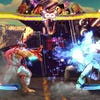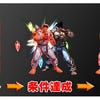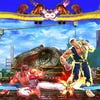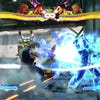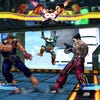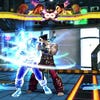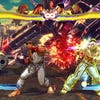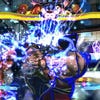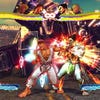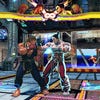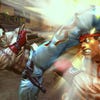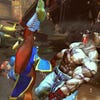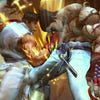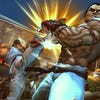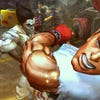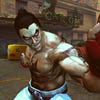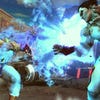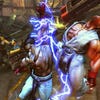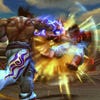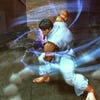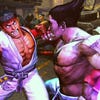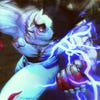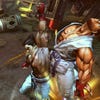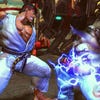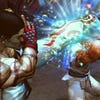Street Fighter x Tekken Review
From Kuma to Akuma.
It's not the first time that two rival fighting game families have come together in a controversial, unexpected marriage. But when Capcom and SNK ran away together a decade ago, at least the two parties lived on the same side of town: 2D, sprite-based fighters that shared DNA and - in the case of some members of the Street Fighter and King of Fighters casts - a creator in Takashi Nishiyama.
By contrast, Tekken and Street Fighter hang at different ends of the fighting game family tree: entirely different creatures that share a genre but no family likeness whatsoever. Street Fighter is defined by sweeping stick motions, sneaky cross-ups and punctuation-mark special moves. Tekken, by contrast, is known for its visual spectacle, quick jab stick motions and four-button combination button presses. Few tournament players double-dip, as the mental and physical approach required for each is so radically different. You're born Street Fighter or you're born Tekken. Never the twain shall meet.
And yet, in this meeting, we find a marriage that not only works - it transforms and inspires. Street Fighter is the dominant partner (while Tekken will take the lead in Namco's version of the game, whenever it surfaces) and the foundations of the game are built from Street Fighter 4's building blocks and aesthetics. Players who have grown proficient with Ryu, Ken, Chun-Li and the other big ticket characters from Capcom's recent fighting game resurgence will slip into the roles like a comfy old gi, the move lists and inputs mostly shared, even if the speed and timbre of the outputs are quite different.
It's a faster game, for starters, sitting somewhere between the weighty thoughtfulness of Street Fighter 4 and the ADHD jitter of Marvel vs. Capcom 3. The tag team backbone, which has you tapping the two medium attack buttons to switch partners in and out of play, adds to the rapid-fire tempo, while the fussy double-turn inputs for Ultras have been cut in two to lower the barrier for entry to newcomers.
Indeed, Capcom has focused on making the game as accessible as possible. Gems, the most controversial design introduction that allow players to equip up to three additional buffs (more on this later), even offer beginners the chance to use a slot to simplify the physical commands required to input moves.
Likewise, the Cross Rush - composed by striking any attack buttons in ascending order of strength - will send your character into a lavish combo that ends with a launcher move before tagging in your second character to continue the attack. It's a simple system that yields immediately effective results, although without all of the visual bluster of MVC3, which could make newcomers feel as though they were button-mashing for fireworks.
At the other end of the scale, however, Capcom has worked hard to make this one of the most tactically and mechanically rich fighting games it has ever constructed. The introductory lessons take a good 20 minutes to complete as Street Fighter's resident goon Dan guides you through mechanic after mechanic for high-level play. You have a Cross Gauge, a special meter divided into three sections that fills as you execute attacks.
One section of the gauge can be spent in a variety of ways, unleashing EX versions of your standard special moves that have stronger properties, as per Street Fighter IV. A section can also be spent on a Cross Cancel, which allows you to counter from a block with a launcher, sending your opponent high into the air, or a Switch Chance, which allows you to tag in your partner mid-combo for Tekken-style juggling.
Two sections of the gauge will allow you to execute a Super Art, the game's version of Street Fighter 4's Ultras, while if you have a full gauge you can spend it all on a Cross Art, which will have both members of your team perform a combo Super Art for huge damage. Alternatively, the entire gauge can be splurged on a Cross Assault, a dazzling two-man attack that brings your partner onto screen to join in the attacking for a few seconds under AI control.
Finally, Pandora - a sort of kamikaze gamble - can be triggered if your on-screen character has 25 per cent health or less, a move which will kill the character while imbuing your partner with a gigantic boost of power. However, this only lasts for ten seconds and, if you fail to win the match within that time, your second character also falls to the floor, defeated.
Never has a Street Fighter game been so mechanically rich, and the strategic possibilities of this cat's cradle of systems and ideas are overwhelming. Add into this the huge roster of 38 characters (the largest in any Street Fighter game), all of whom can be paired to create teams with unique strengths and weaknesses, and you have a game that will reveal its depth and potential over months and years, not days and weeks.
As if all of this weren't enough, Capcom has made the bold decision to introduce upgrades that can be equipped to each character. Rendered as 'gems', these upgrades come in five different types, improving your attack, defence, speed, vitality or cross gauge capacity.
Street Fighter and Tekken have always eschewed upgrades, maintaining a purity of focus that demands players upgrade themselves, not their characters, in order to improve their chances of winning. No matter how well balanced, the gem system makes a clear dent on this purity. Nevertheless, the integration is more subtle and sympathetic than many have feared. Few gems are 'always on' and those that are, such as the Easy Input and Super Easy Input gems, offer no statistical benefit to your character - although the gem that allows you to always escape throws is immediately irritating when you are the thrower.
Instead, gems must be activated during play by meeting certain conditions. For example, the Immense Power gem will increase your character's damage output but the effect only lasts for 20 seconds - and only when you have had an attack blocked by an opponent four times. Likewise, the Iron Wall gem reduces damage incurred by 20 per cent for 15 seconds when you successfully block ten times. The gems fire on and off dynamically, the indicator of an active effect being a glow around your character. Gem set-ups enable players to compensate for weaker areas of their game, but also give your opponent an indication of your play style - and of course, with over a hundred gems available, the tactical possibilities here are gigantic.
Beyond the minutiae of mechanics, Capcom has introduced a number of multiplayer innovations that make Street Fighter x Tekken the most exciting co-operative fighting game yet made. Online, you may now pair up with another fighter to take on other two-man teams, each player controlling one character in a normal tag match. An online Briefing Room allows players to train together remotely and it's exciting to see how two-vs.-two matches will be incorporated into the tournament scene.
Scramble mode sees Capcom letting its hair down with a party mode that has four players all fighting on screen at once, either online or off. It's riotous fun. Meanwhile, the usual array of SF4: Arcade Edition lobbies and match videos make an appearance, providing the game with a framework for community-building from day one.
The netcode has been rewritten from Street Fighter 4 to allow for the four-player co-op and faster pace, but in the week ahead of release, there do appear to be some significant teething issues. Most notably, sound effects are almost completely broken in all online modes, spoiling the sheen of what is, undeniably, a hugely ambitious project. Hopefully this will be fixed in a launch patch but for now, it sullies the online experience.
Capcom is often charged with failing to substantially innovate in its iterative fighting games. Street Fighter x Tekken is a sucker-punch to the stomach of that accusation, revealing a design team drunk on ideas. It's vibrant and exciting - although, of course, with the sheer number of variables now in play, it's entirely possible that players will find exploits to upset the fine balance of the game, requiring some of the iterative work for which Capcom is so well known.
It's undeniably a more fussy game than Street Fighter 4, and at times you may hunger for a return to the relative simplicity of the elder Street Fighters. But this is a game built around options - how you want to deploy your meter, who you want to partner with, the colours and gems that you want to dress them in.
We already have Third Strike and Street Fighter 4. We don't need another one. This ripped, boisterous crossover game arrives in a blaze of creativity, one of an intensity rarely seen in Japanese game output of late. A fierce, passionate marriage then - but one that just might last.



